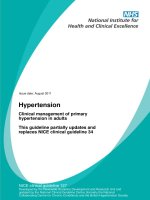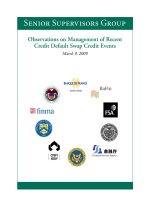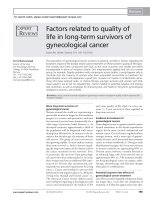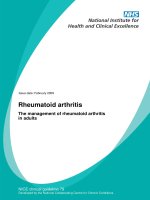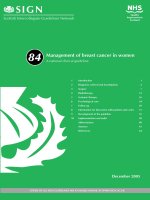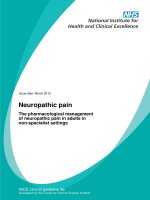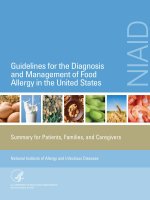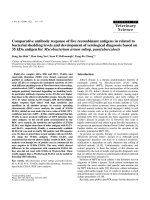Factors related to mothers home practicer on management of accute diarrhea in children under five years old, in nam dinh city, viet nam
Bạn đang xem bản rút gọn của tài liệu. Xem và tải ngay bản đầy đủ của tài liệu tại đây (3.52 MB, 98 trang )
FACTORS RELATED TO MOTHERS’ HOME PRACTICES ON
MANAGEMENT OF ACUTE DIARRHEA IN CHILDREN UNDER
FIVE YEARS OLD, IN NAM DINH CITY, VIET NAM
___I
NGUYEN MANH DUNG
A
A THESIS SUBMITTED IN PARTIAL FULFILLMENT OF
THE REQUIREMENTS FOR THE DEGREE OF
MASTER OF PRIMARY HEALTH CARE MANAGEMENT
FACULTY OF GRADUATE STUDIES
MAHIDOL UNIVERSITY
2002
ISBN: 974-04-1355-2
COPYRIGHT OF MAHIDOL UNIVERSITY
Thesis
entitled
FACTORS RELATED TO MOTHERS’ HOME PRACTICES ON
MANAGEMENT OF ACUTE DIARRHEA IN CHILDREN UNDER FIVE
YEARS OLD, IN NAM DINH CITY, VIET NAM
was submitted to the Faculty o f Graduate Studies, Mahidol University
for the degree of Master o f Primary Health Care Management
on
M arch2 0 ,2 0 0 2
Mr. Nguyen M anh Dung
Candidate
Asst. P ro f Nonglak Pancharuniti
D.D.S., M.P.H., Dr.P.H.
Chair
Kiitf
Sliiyabp
Lect. Kitti Shiyalap
B.Sc. in Pharm., M.P.H., Ph.D.
Member
Asst. P ro f Junya Pattaraarchachai
B.Sc., M.Sc., M.S.P.H., Sc.D.
M ember
Asst. Prof. Somsak Wongsawass
ngsawass
B.Sc., M.Sc., M.P.H.
Member
Prof. Liangchai Limlomwongse
Ph.D.
Dean
Faculty o f Graduate Studies
Mahidol University
Prof. Som-arch Wongkhomthong
M.D., D.H.Sc.
Director
ASEAN Institute for Health Development
Mahidol University
Thesis
entitled
FACTORS RELATED TO MOTHERS’ HOME PRACTICES ON
MANAGEMENT OF ACUTE DIARRHEA IN CHILDREN UNDER FIVE
YEARS OLD, IN NAM DINH CITY, VIET NAM
Candidate
Asst. P ro f Nonglak Pancharuniti
D D S , M.P.H., Dr.P.H.
Major-advisor
ỈCTíHí
Lect. Kitti Shiyalap
B.Sc.in Pharm., M.P.H., Ph.D.
Co-advisor
Qjci
Asst.Prof. Somsak Wongsawass
B.Sc., M.Sc., M.P.H.
Co-advisor
a
7
ẳ
Prof. Liangchai Limlomwongse
Ph.D.
Dean
Faculty o f Graduate Studies
Nssvj^.
Asst Prof Boonyong Keiwkamka
Dr.P.H.
Chair
i
M aster o f Primary Health Care Mangement
ASEAN Institute for Health Development
iii
ACKNOWLEDGEMENT
This thesis would not have been possible without the help and support of many
people.
First and foremost, it is my honour and pleasure to express my sincere gratitude
to Asst. Prof. Nonglak Pancharuniti, my major-advisor, for her valuable guidance,
support and inspiration throughout the thesis period. Her effort, assistance and
commitment made the entire thesis process an enjoyable time that I will always live to
remember.
I am also grateful to Dr. Kitti Shiyalap and Asst. Prof. Somsak Wongsawass, my
co-advisors, for their kindly advice, guidance and encouragement during the thesis
process. More specifically, I appreciate their support and guidance with regard to
thesis analysis and general review of my thesis that led to its successful completion.
Furthermore, I express my sincere thanks to Asst. Prof. Junya Pattaraarchachai, for her
valuable suggestions and comments, especially during the last moments of my thesis.
I will always be grateful to you all.
Also, I express sincere thanks to the Vietnamese Ministry o f Health, and the
Namdinh Medical College for selecting me to participate in the Master of Primary
Health Care Management course at ASEAN Institute for Health Development. My
special thanks go to the Canadian International Development Agency (CEDA), and
operated by the Association of Universities and Colleges o f Canada (AUCC), a
partnership between the School of Nursing, Memorial University o f Newfoundland,
Canada, and the Secondary Technical Medical School 1 (STMS1), Ministry of Health,
Vietnam. The author would like to thank the project Director, Dr. Lan Tran Gien,
Professor, Nursing, Memorial University, Dr. Hoang Dien Phan and Dr. Vu Dinh
Chinh (project Co-Directors) for their encouragement and support that enabled me to
attend this course.
I am also grateful to the leaders o f Namdinh health center, all the health
personnel and respondents for their cooperation and assistance during the time of data
collection. Their support and enthusiasm made the entire data collection process a
memorable experience for me.
I am also grateful to all the professors and staff o f the AIHD, the MPHM office,
the computer department, the library center as well as my classmates for supporting me
to complete my thesis successfully. I also thank the ASEAN house staff for their
facilities during my stay in ASEAN house
Last but not least, I express my gratitude to my family members, relative and
friends for according me the moral support and motivation throughout my study at the
ASEAN Institute for Health Development, Thailand.
Nguyen Manh Dung
Trường đại học tống hợp Mahidol Thái lan
Tóm tắt đé tài/iv
SỐ 4437629:
CHỦ ĐỀ: QUẢN LÝ CHĂM SÓC s ú c KHOẺ BAN ĐẦU
ĐỀ TÀI THẠC SỸ QUẢN LÝ CHĂM SÓC s ú c KHOẺ BAN ĐAU
TỪKHỌÁ : BỆNH TIÊU CHẢY/ THIJC HÀNH TẠI NHÀ/ TRẺ EM/ VIỆT NAM
CHỦ ĐỀ TÀI:
NGUYỄN MẠNH DŨNG
TÊN ĐỀ TÀI: CÁC YÊU T ố LIÊN QUAN ĐẾN t h ụ c HÀNH TẠI NHÀ CỦA BÀ MẸ
TRONG VIỆC X Ử TRÍ BỆNH TIÊU CHẢY CẤP Ở TRẺ EM DƯỚI 5 T U ổI, TẠI THÀNH
PHÓ NAM ĐỊNH, VIỆT NAM.
NHỮNG NGƯỜI HƯỚNG DAN:
PGS. TS. NONGLAK P A N C H A R U N m , TS. K i m SHIYALAP
PGS. THS. SOMSAK WONGSAWASS.
MÃ SỐ XUẤT BẢN: 974-04-1355-2.
Đề tài nghiên cứu được thiết kế theo kiểu nghiên cứu cắt ngang,, được thực
hiện để xác định các yếu tố liên quan tới thực hành tại nhà của các bí mẹ trong
việc xử trí bệnh tiêu chảy cấp ở trẻ em dưới 5 tuổi, tại thành phố Nam Định, Việt
Nam.
270 bà mẹ có con bị bệnh tiêu chảy trong vòng 6 tháng gần đây, đã được
phỏng vấn trực tiếp (thông qua bộ câu hoi) để thu thập các thông tin, sử dụng
trong nghiên cứu này. Nó bao gồm: Các đặc điểm về nhân khẩu-xã hội học, nhân
thức về sự nhạy cảm, sự nguy hiểm của bệnh tiêu chảy ở trẻ em cùng với lợi ích,
những điều trở ngại cũng như các điều gợi ý giúp đỡ bà mẹ trong thực hành và việc
thực hành tại nhà của các bà mẹ trong xử trí bệnh tiêu chảy cấp ờ trẻ em.
Sự phân tích kết quả nghiên cứu đã chỉ ra rằng: Phần lớn các bà mẹ ở độ
tuổi từ 26-34, có trình độ VH hết phổ thơng trung học và có thu nhập ở mức thấp.
Các bà mẹ trong nghiên cứu này chủ yêú là: nội trợ, làm nghề tự do và có tổng số
người trong gia đình khơng q 4 người. Số đông trong họ đã nhận được các thông
tin về liệu pháp bù nước và điện giải từ nhân viên y tế. Tồn bơ nhận thức của họ
đã được phân loại trung bình: 52^6%, mức cao: 33%. Có 38% bà mẹ (Ịạt mức cao
về điểm thực hành, mặc dù 50% bà mẹ đã thực hiện tăng lượng nước uống cho trẻ,
65.6% tiếp tục cho trẻ ãn, 54.8% đã khơng sử dụng bất kỳ loại thuốc nào, 55.2%
đã có được nhận thức về các dấu hiệu nặng của bệnh khi con họ bị tiêu chảy và
67.4% bà mẹ đã có được hành vi thực hành rửa tay đúng trong khi chăm sóc trẻ
Spearman correlation test đã đưa ra kết quả: mối liên quan có ý nghĩa
thống kê giữa điểm thực hành tại nhà của các bà mẹ với tổng số năm học (VHGD), tổng số thành viên trong gia đình, tổng số ưẻ dưới 5 tuổi trong gia đình, nhận
thức của bà mẹ về bệnh tiêu chảy, cũng như các điều gợi ý giúp đỡ bà mẹ trong
thực hành với giá trị r, mong đợi tương ứng, 0.334, 0.305, 0.444, 0.277 và 0.380.
Kết quả nghiên cứu cũng chỉ ra rằng: Thực hành tại nhà của các bà mẹ trong xử trí
bệnh tiêu chảy cấp ở trẻ em dưới 5 tuổi là cao hơn có ý nghĩa trong; nhóm các bà
mẹ đang làm việc tại các cơ quan, xí nghiệp nhà nước (p=0.005)
Fac. of Grad. Studies, Mahidol Univ.
Thesis /iv
4437629 ADPM/M: MAJOR: PRIMARY HEALTH CARE MANAGEMENT
M.P.H.M (PRIMARY HEALTH CARE MANAGEMENT)
KEY WORDS :
DIARRHE A/HOME PRACTICES/ CHILDREN/VIETN AM
NGUYEN MANH DUNG: FACTORS RELATED TO MOTHERS' HOME
PRACTICES ON MANAGEMENT OF ACUTE DIARRHEA IN CHILDREN
UNDER FIVE YEARS OLD, IN NAM DINH CITY, VIETNAM.
THESIS ADVISORS: NONGLAK PANCHARUNITI D.D.S.,M .P.H, Dr.P.H,
KITTI SHIYALAP B.Sc. IN PHARM , M.P.H., Ph.D.,
SOMSAK WONGSAWASS B.Sc, M.Sc., M.P.H., 103p. ISBN: 974-04-1355-2.
This thesis is a cross- sectional study, conducted to identify factors related
to mothers' home practices on management o f acute diarrhea in children under
five years old, in Namdinh City, Vietnam.
The subjects were 270 mothers who had children with diarrhea in the lasf
six months. A structured interview questionnaire was used to collect the
information in this study. This included their socio-demographic characteristics,
perception to susceptibility, severity o f childhood diarrhea in accordance with
benefit, barrier, cues to action to support mothers on home practices and mothers'
home practices on management of acute diarrhea in children
The analysis indicated that, the majority o f mothers were with the age
between 26-34 years, graduated at secondary school, and having low income.
Most o f them were self-employed or housewives, and with small family size (< 4
people in the family). M ost of them had received information o f Oral Rehydration
Therapy from health personnel. Over all o f their perception about childhood
diarrhea and home practices on management o f acute diarrhea was classified to be
moderate (52.6%) and up to high level (33%). About 38% o f mothers had high
level of practice score, although 50% of them would feed the children with more
fluid, 65.6% continue feeding, 54.8% didn't use any drugs, 55.2% recognized*
dangerous signs, and 67.4% had hygiene behavior o f washing hands.
Spearman correlation gave the statistical significant results o f the
relationship between mothers' home practices and total years o f education of
mothers, total family members, family's income, total number children under five
years old in the family, mothers' perception o f diarrhea and dies to action of
mother with rs equal to, 0.334, 0.305, 0.444, 0.441, 0.277, and 0.380 respectively.
It was also found that the score o f mothers' home practices on management of
acute diarrhea in children was significantly higher in the group o f mothers
working for the government (p= .005)
CONTENTS
Page
ACKNOWLEDGEMENT.................................................................................................. iii
ABSTRACT.......................................................................................................................... iv
LIST OF TA B LES.............................................................................................................,vii
LIST OF FIGURES..............................................................................................................ix
LIST OF ABBREVIATIONS.............................................................................................. x
CHAPTER
I
INTRODUCTION
1.1 Rationale and justification of study................................................................. 1
1.1.1 Magnitude of diarrhea among children Worldwide and Vietnam... 1
1.1.2 Case managementof acute diarrhea....................................................2
1.1.3 Practice o f mothers on management o f acute diarrhea
in children............................................................................................ 3
1.1.4 Problem statem ent................................................................................4
1.2 Research obj ective.............................................................................................6
1.2.1
General objective.................................................................................6
1.2.2
Specific objectives................................................................................6
1.3 Conceptual frame w o rk .................................................................................... 7
1.4 Operational definition.......................................................................................'8
1.5 Usefulness of the study..................................................................................... 11
1.6 Scope and limitations of the study...................................................................12
1.7 H ypothesis.......................................................................................................... 12
H
LITERATURE REVIE
2.1 Epidemiology o f diarrhea.................................................................................. 13
2.1.1 Present global situation of diarrheal disease...................................... 15
2.1.2 Present situation o f diarrheal disease in Vietnam ............................17
2.2 Management o f diarrhea in children at home.......................
18
2.2.1 Give the children more fluid than as u su al..............
19
2.2.2 Continue feeding the children.............................................................. 22
2.2.3 Take the child to a health worker i f ...................................................2
2.2.4 Using antibiotic and antidiarrheal drugs............................................. 27
2.2.5 Behavior o f hygiene practice of mothers...................
29
2.3 Health beliefs m odel..........................................................................................»31
2.3.1 Perceived susceptibility.........................................................................31
2.3.2 Perceived severity................................................................................. 31
2.3.3 Perceived benefit of taking action and barriers..................................31
vi
CONTENTS (Cont.)
Page
2.4
Factors related to mothers' home practice................................................. 36
2.4.1 Socio-demographic factors o f mothers.......................................... 36
2.4.2 Perception of mother toward diarrhea in children.........................37
2.4.3 Cues to action support mother on managing acute diarrhea........40
III
RESEARCH METHODOLOGY
3.1 Study design.....................................................................................................42
3.2 Study population............................................................................................42
3.3 Sample size estimation.................................................................................... 42
3.4 Study area........................................................................................................ 43
3.5 Instrument........................................................................................................ 45
3.6 Data collection................................................................................................ 47
3.7 Data analysis....................................................................................................48
IV
RESULTS
Results....................................................................................................................... 49
V
DISCUSSION
Discussion..................................................................................................................67
VI
CONCLUSION AND RECOMMENDATIONS
Conclusion................................................................................................................ 75
Recommendation.................................... ................................................................. 77
REFERENCES...................................................................................................................80
APENDIX
‘
A
Questionnaires.................................................................................................87
B
The result o f test normal distribution.......................................................... 98
C
Summary of the results.................................................................................. 99
BIOGRAPHY....................................................................................................................103
Vil
LIST OF TABLES
*
TABLES
Page
1
The main types o f diarrhea............................................................................. 13
2
Estimates o f diarrhea associated death, 1995............................................... 16
3
Selected communicable disease in SEAR countries, 1995.......................... 16
4
Summary o f findings about using O R S......................................................... 21
5
Summarized guideline of WHO/CDD about amount fluid supplied for
children with acute diarrhea............................................................................. 22
6.
Summary of findings about mothers' home practice on feeding children with
diarrhea...............................................................................................................25
7
Summary how to supply food for children with acute diarrhea................... 26
8
Number and percentage of respondents classified by socio-demographic
characteristics................................................................................................... 51
9
Percentage o f respondents classified by mothers' perception toward
diarrhea in children............................................................................................. 53
10 Number and percentage of respondents' by level o f perception.................. 55
11
Number and percentage o f respondents classified by cues to action......... 57
12 Number and percentage of respondents' by level o f cues to | action............ 58
13
Number and percentage of mothers by their practice on home care
management o f acute diarrhea in children...................................................... 60
14 Number and percentage of mothers by their correct practice on home care
m
management o f acute diarrhea in children...................................................... 61
15 Number and percentage o f respondents by level of their practice score.... 62
16 Association between mothers' home practice score and
their occupation by Kruskal-Waliss test.......................................................... 63
17 Correlation analysis between test......................................................................64
18 Correlation analysis between practice sore and perception score by
Spearman rank correlation te st......................................................................... 65
V lll
LIST OF TABLE (Cont.)
TABLES
19
Page
Correlation analysis between cues to action score and practice score by
Spearman rank correlation T est........................................................................ 66
20
The result test normal distribution ( Kolmogorov-Smirnov test).................. 98
21
Correlation analysis between socio-demographic factors and susceptibility by
Spearman rank correlation te s t..........................................................................99
22
Correlation analysis between other items o f perception and
susceptibility........................................................................................................99
23
Correlation analysis between susceptibility and cues to action.................... 99
24
Correlation analysis between barrier and socio-demographic factors..........99
* 25
Correlation analysis between barrier and others items o f perception......... 100
26
Correlation analysis between and diarrheal episodes o f children ............. 100
27
Correlation analysis between benefit and socio-demographic factors........ 100
28
Correlation analysis between benefit and other items o f perception.......... 100
29
Correlation analysis between cues to action and socio-demographic factors
by Spearman rank correlation test................................................................... 101
30
Correlation analysis between cues to action and diarrheal episodes of children
by Spearman rank correlation test................................................................... 101
31
Correlatiion analysis between diarrheal episodes o f children and scociodemographic factors o f mothers by Spearman rank correlation te s t.........101
32
Correlation analysis between diarrheal episodes o f children
and practice.........................................................................................................101
33
Correlation analysis between diarrheal episodes o f children and perception by
Spearman rank correlation te s t........................................................................ 102
34
Correlation analysis between income and socio-demographic facto rs......102
35
Correlation analysis between total perception and m otivation.................. 102
LIST OF FIGURES
FIGURES
Page
1. Trend in diarrheal disease in Vietnam, 1992-1998.....................................................17
2. The Health Belief M odel.................................................................................................35
3. Diagram for data collection processing......................................................................... 46
4. Percentage o f respondents’ by level of perception score............................................ 56
5. Histogram o f respondents' by cues to action............................................................... 58
6. Histogram o f respondent by practice........................................................................... 62
X
1
LIST OF ABBREVIATIONS
!:
"1■
j
:
j
AIHD:
ASEAN Institute for Health Development
CDD:
Control Diarrheal Disease
CEDA:
Canadian International Development Agency
IMCI
Integrated Management o f Childhood Illness
MoH:
Ministry of Health.
!
:
M.P.H.M: Master Primary Health Care Management
ORT:
Oral Rehydration Therapy
ORS:
Oral Rehydration Sait
SEAR:
South East Asia Regions
SSS:
Salt-Sugar-Solution
STMS1:
Secondary Techniccal Medicine School No 1
UNICEF:
United Nations Children's Fund
VND:
Vietnamese Dong (Vietnam Currency Unit)
Exchange rates: 1 US$ « 15,010 VND
US$:
United States' currency unit: Dollar
WHO:
World Health Organization.
♦
Fac. of Grad. Studies, Mahidol Univ.
M.P.H.M (PHC Management) / 1
CHAPTER I
INTRODUCTION
1.1 Rationale and justification of the study
1.1.1 Magnitude of diarrhea among children worldwide and in Vietnam
Each year, globally more than eleven million children die from the effects
of many diseases and inadequate nutrition. In some countries, more than one in five
children die before they reach their birthday, and many o f those who do survive are
unable to grow and develop to their full potential. Seven out of ten childhood deaths
in developing countries can be attributed to just one main cause, or often to a
combination o f diseases such as pneumonia, diarrhea, measles, malaria and
malnutrition (1)
Diarrheal diseases are a leading cause o f childhood mortality in
developing countries and an important cause of malnutrition. On average, children
below 3 years o f age in developing countries experience three episodes of diarrhea
each year. In 1993, an estimated 3.2 million children below 5 years died from diarrhea
(2). Diarrheal disease is related to more than 3 million deaths and more than 4 billion
episodes in 1995, o f which more than 80% were among children under five years old.
About 50% o f deaths from diarrhea are due to acute watery stool, 35% to persistent
diarrhea and 15% to dysentery (3.)
In 1999, causes o f 10.5 million deaths among children under five years in
developing countries were pneumonia 18%, diarrhea 15%, malnutrition 49%, measles
8%, malaria 7% and HIV/AIDS 3%. One in every two-child death in developing
countries is due to the above infectious diseases and malnutrition (4).
Fac. of Grad. Studies, Mahidol Univ.
M.P.H.M (PHC Management*/ 2
Dehydration caused by diarrhea is a major cause o f death among children
in Vietnam. In 1998, as recorded in hospitals among the children, diarrhea is the
second disease in ten leading causes of morbidity and it is the ninth in ten leading
causes o f death (5). Especially, in the Mekong delta diarrheal diseases are prevalent,
ubiquitous and the mortality and morbidity rates are the highest compared to other
areas in Vietnam. Gastrointestinal diseases (including diarrhea diseases) represent
60% among the total number o f cases for 24 communicable diseases reported to the
Ministry of Health (MOH). Among gastroenteritis, diarrhea contributes approximately
90% of cases. In 1998 there were 2701.6 diarrhea cases per 100 thousand children,
which was rather high (6)
Diarrhea is not the only direct cause o f death, but also the cause of
malnutrition, especially in infants and children under five years old. Repeated
episodes o f diarrhea contribute to malnutrition and are more likely to cause death in
children who are malnourished. Therefore, diarrheal diseases and malnutrition
constitute a vicious cycle leading to increased rate o f child morbidity and mortality.
Diarrhea also presents an economic burden for the developing countries. In many of
these countries, children with diarrhea occupy a large amount o f hospital beds each
year. They also require expensive intravenous fluids, which in the long run affect the
country's economy by reducing the health o f its work force. (7)
1.1.2 Case management of acute diarrhea
Seven out o f ten childhood deaths in developing countries can be
attributed to just five main causes or combination o f them: pneumonia, diarrhea,
measles, malaria, and malnutrition. Around the world, three out o f every four children
who seek health care suffer from at least one o f these conditions. However, better
health management can prevent many o f these deaths. World Health Organization
(WHO) recommends the Integrated Management o f Childhood Illness (EMCI)
approach in the management of these diseases.
Fac. of Grad. Studies, Mahidol Univ.
M.P.H.M (PHC Management) / 3
World Health Organization's treatment guidelines are based on the major
features o f the disease. The following principles guide the treatment of the diarrhea
include:
- Watery diarrhea requires replacement of fluids and electrolytes,
regardless o f the cause o f the diarrhea. For most patients, this can be accomplished
with an Oral Rehydration Salt (ORS) solution or Sugar Salt Solution (SSS). Severely
dehydrated patients can be rehydrated intravenously with Ringer's Lactate solution.
- Feeding should be continued during all types o f diarrhea to the greatest
extent possible. It also should be increased after the diarrhea stops to avoid the effects
o f malnutrition.
- Increase fluids as soon as diarrhea starts and continue feeding. These
two keys can ensure that 90% o f diarrhea cases can be treated successfully at home,
without requiring the assistance o f health workers (1)
- Drugs should not be used routinely. Drug treatment does not help in
most episodes o f diarrhea, including severe diarrhea with fever. The only exception to
this is dysentery (with bloody stool), suspected case o f cholera and some cases of
persistent diarrhea. The WHO recommendation is that antidiarrheal and antiemetic
drugs should never be used to treat diarrhea in children. None o f these drugs has
practical value and some are dangerous. (2)
*
1.1.3 Practice of mother on management of acute diarrhea in children at
home
Practice o f mother on management o f acute diarrhea in children at home
or home care for acute diarrhea in children under five years old was defined as the
following included 3 rule as:
Fac. of Grad. Studies, Mahidol Univ.
M.P.H.M (PHC Management) / 4
- Rule 1: Give extra fluids intake,
- Rule 2: Continuing food
- Rule3: Recognize danger signs and bring the child to the health worker
for check up. Six danger signs of acute diarrhea in children under five years old are:
fever, repeated vomiting, bloody stool, not able to drink or breast-feed adequately,
does not better (the passage o f many watery stool)(2)
And recommendation: do not give a child any antidiarrheal preparation,
antibiotic drugs and adopt significant preventive behavior.
1.1.4 Problem statement
Many children die because their parents do not recognize warning signs
that indicate their children might be suffering from one or more o f the above illness.
Changing family habits and the kinds o f food offered to children is an important
element o f Integrated Management of Childhood Illness (IMCI) approach. Correct
management o f diarrhea could save the lives of up to 90% o f children who currently
die from the effects of the disease.
An important element of IMCI approach is the encouragement of a
healthier home life. Through IMCI, health workers can counsel parents on how to
improve care for their sick children. Workers teach them how to administer drugs to
combat pneumonia, how to follow the three rules o f home care for diarrhea- increase
fluids, continue feeding and recognize the danger signs that mean their children needs
further treatment in a health facility (7).
More than 20 countries have begun to implement the IMCI strategy at
regional and local levels since treatment guidelines and training materials first became
available in 1996. Representatives of many o f these countries have reported in
conferences their success in reducing child mortality rates. Other 20 countries have
expressed interest in IMCI approach (8).
Fac. of Grad. Studies, Mahidol Univ.
M.P.H.M (PHC Management) / 5
Acute watery diarrhea is the most common form and the most easily
treated. It may cause dehydration, which can usually be avoided by giving extra fluids
and food with a little extra salt. Oral Rehydration Salt solution can safely correct
i
dehydration without the need for intravenous therapy in all but the most severe cases
(7)
The situation o f diarrhea in Vietnam with a population of 78.7 million,
diarrhea in children is a major public health problem. Although mortality rates
attributable to diarrheal diseases have been progressively decreasing in recent years.
Morbidity rate has been one o f the most important health problems. Mortality rate of
children under five years old is 40 per 1,000 live births (9). Only 18% of rural
households have access to proper sanitation facilities. Poor environmental sanitation,
lack of knowledge and failure to put knowledge into practice contribute significantly
to this problem (10)
In Vietnam, mothers are mainly responsible in taking care of children
during the childhood and hence they are the ones who mostly influence the health of
their children. The health beliefs of mother toward diarrheal disease in children play a
crucial role in their practice o f child feeding, drinking, personal hygiene, sanitation
*
and care o f their children when they have acute diarrheal disease at home.
Therefore, the study o f factors related to mothers' home practice on
management o f acute diarrhea among children under five years old, in Namdinh City,
Vietnam is plausible and a priority.
It is important to explore the factors related to correct and incorrect
practice o f mothers on management of acute diarrhea in children at home. This
information can be used as baseline data for future diarrheal prevention and treatment
program in this area.
Fac. of Grad. Studies, Mahidol Univ.
M.P.H.M (PHC Management) / 6
1.2 Research objective
I
1.2.1 General objective:
To study factors related to mothers’ home practice on management of
acute diarrheal disease among children under five years old, in Namdinh City,
Vietnam.
1.2.2 Specific objectives
1.2.2.1 Determine Socio-Demographic factors o f mothers who have
children under five years old with acute diarrhea
1.2.2.2 Identify perception of mother about diarrhea in children
1.2.2.3 Identify the cues to action toward managing acute diarrhea* in
children
1.2.2.4 Identify practice of mother on management o f acute diarrhea in
children at home
1.2.2.5 Determine association between Socio-Demographic factors of
mother with their perception o f diarrhea and their practice on managing acute diarrhea
in children, under five years old at home
Fac. of Grad. Studies, Mahidol Univ.
M.P.H.M (PHC Management) / 7
1.3 C onceptual fram e w ork
Independence
-
Socio-dem ographic
factors of m others
Age
Education
Occupation
Monthly income
Family size
Perception of m others
toward diarrhea in children
under five years old
- Susceptibility
- Severity
- Benefit
- Barrier
- Motivation
Cues to action
- Mass media campaigns
- Advice from family
member or other
- Experiences o f mothers
with diarrhea in children
(diarrheal episodes o f
children in the last 6 months)
Dependent
▼
Practices of m others
on management of
acute diarrhea in
children under five
years old at home ♦
- Increasing fluid:
ORS, SSS
-►
breast milk
- Continue feeding
- Medication
- Recognized
dangerous signs
- Behaviors o f
hygiene practice
Fac. of Grad. Studies, Mahidol Univ.
M.P.H.M (PHC Management) / 8
1.4 Operational definition
Diarrhea: Diarrhea is a group of signs and symptoms which describes how
frequent “defecation” is and what are characteristics o f the fecal matter. It is a usually
defined as the passage o f three or more loose or watery stool in 24-hour period (11).
Classification of diarrhea, according to World Health Organization, there are
three main types o f diarrhea.
1 Acute watery diarrhea is the most common form and the most easily treated
(an episode of diarrhea lasts less than 2 weeks). It may cause dehydration, which can
usually be avoided by giving extra fluids and food with a little extra salt. Oral
Rehydration Salts solution can safely correct dehydration without the need for
intravenous therapy in all but the most severe cases.
2 Dysentery is diagnosed by the presence of blood in the stools and is treated
with antibiotics.
3 Persistent diarrhea is defined as an episode that lasts for more than 14 days *
Diarrheal episode: An episode of diarrhea o f children is an interval in which
the definition o f diarrhea is met and starts at the beginning to the end o f the disease.
Two subsequent episodes o f diarrhea are separated by an interval o f normal stool at
least 3 days.
Dehydration: During diarrhea there is an increased loss o f water and
electrolytes (sodium, chloride, potassium, and bicarbonate) in the liquid stool. Water
and electrolytes are also through vomit, urine and breathing. (2).
Fac. of Grad. Studies, Mahidol Univ.
M.P.H.M (PHC Management) / 9
The classification of dehydration is graded according to the signs and
symptoms that reflect the amount of fluid lost:
- In the early stages of dehydration, there are no signs or symptoms.
- As Dehydration increases, signs and symptoms develop. These include: thirst,
restless or irritable behavior, decreased skin turgor, dry mucous membranes, sunken
eyes, sunken fontanel (infants), and absence o f tears when crying vigorously
- In severe dehydration, these effects become more pronounced and the patient
may develop evidence of hypovolaemic shock. Death follows soon if rehydration is
not started quickly.
Oral Rehydration Therapy (ORT), This is method o f rehydration by oral
administration o f fluids, in order to correct and prevent dehydration, which is a
consequence o f diarrhea
- Oral Rehydration Salt (ORS) refers to fluid for treatment o f diarrheal disease
to reduce the severity o f dehydration and to prevent deaths. Universally recommended
formula containing o f Sodium Chloride: 3.5 grams, Sodium Bicarbonate: 2.5 grams,
Potassium Chloride: 1.5 grams, Glucose: 20 gram to be dissolved in one liter of
drinking water.
- Homemade Sugar Salt Solution (SSS): a special drink (salt, sugar and water)
can be made to treat o f diarrhea and prevent dehydration at home. In one liter of
drinking water add: sugar: 8 teaspoons (making level full o f each), salt: 1 level
teaspoonful (2)
Malnutrition in Diarrhea: during diarrhea, decreased food intake, decreased
nutrient absorption, and increased nutrient requirements often combine to cause
weight loss and failure to grow (2)
Fac. of Grad. Studies, Mahidol Univ.
M.P.H.M (PHC Management) / 10
Use of antimicrobials drugs in diarrhea: antimicrobial drugs should be able to
fight effectively against bacteria like Shigella, Chorelra such as: Amoxycillin,
Metronidazole, chloramphenicol, Nitrofurans, Cephaleuxin.(2)
Use of " antidiarrheal" drugs: these agents, though commonly used, have no
practical benefits and are never indicated for the treatment o f acute diarrhea in
children. Products in this category include adsorbents and antimicrobility drugs such
as: smectite, kaolin, loperamid hydrochloride, etc. They do not prevent dehydration or
improve nutritional status, which should be the main objective o f treatment. Some
have dangerous, and sometimes fatal, side effects. These drugs should never be given
to children below 5 years. (2)
Beliefs of mothers following health beliefs model: means the result of
repeated perception closely related to his/her own experiences, culture, customs and
the age of the person in that society. This study takes into consideration, the belief of
the diarrheal disease related to management of acute diarrhea in children at home.
Perceived Susceptibility: maternal believes or perception to the high or low
opportunities o f her child having acute diarrhea and its complicated symptoms.
Perceived Severity: maternal believes or perception regarding seriousness of
acute diarrhea in her child such as dehydration due to acute diarrhea causing death.
Perceived Benefit: maternal believes or perception to the expected outcome of
primary practices at home when her child having diarrhea.
Perceived Barrier: maternal believes or perception to various factors under real
situations which limit conditions in maternal practices when her child'having diarrhea.
Health Motivation: maternal attention and concern to child health and her
health with respect to management o f acute diarrhea in children.
Fac. of Grad. Studies, Mahidol Univ.
M.P.H.M (PHC Management) /11
Cues to action are some things mass media campaigns, advice from family
member or other, experienced o f mother about diarrhea in children, diarrheal episodes
o f children in the last six months. Those stimulate mother to take the recommended
actions on home care management of acute diarrhea in children under five years old.
Home practices on management of acute diarrheal disease among children
under five years old are the performance of the duties and responsibilities of mother,
as practices toward management of acute diarrhea in children includes:
Increasing fluids means during episode diarrhea o f children, mother have to give
him extra fluid (ORS, SSS) to correct or prevent dehydration. In case infant,
increasing fluid means mother give children more milk or breasted than as usual
Continuing food means during episode diarrhea o f children, mothers have to
continue to feed their children as usual to prevent malnutrition
Recognize danger signs means when children get diarrhea, mother observes and
take care o f them recognize the signs fever, blood in the stool, vomits repeatedly,
drink poorly, not able to drink or breast-feeding, do not better, to seek medical care
Using drugs means when children get acute diarrhea mother should not gives
them any antidiarrheal preparation and antimicrobiotic drugs.
Behavior o f hygiene practice o f mother on management o f acute diarrhea at
home, in this study concern about hand washing o f mother to limit transmission
diarrhea to another people
1.5 Usefulness of the study
This study is expected to show factors related to mothers' home practices on
management o f acute diarrhea among children under five years old in Namdinh City,
Fac. of Grad. Studies, Mahidol Univ.
M.P.H.M (PHC Management) / 12
Vietnam. This study is also expected to provide information on the existing practice
of mothers about management acute diarrheal disease in children. This information
can be used as baseline data information for future diarrhea prevention and treatment
program. Furthermore, this study will also provide information about relationship
between socio-demographic factors o f mother, their perception toward diarrhea and
mothers' practice on management of acute diarrhea among children under five years
old at home, which will be helpful for health education program in the community of
Vietnam.
1.6 Scope and Limitations of the study
The study was carried out in four villages in urban Namdinh City, Vietnam.
Therefore, it may not be generalized to the whole Namdinh City. Since this study
needs to be completed in a short period of time, information about practice of mother
was based on a set o f questions given to them, rather than actual observation during
their practice.
1.7 Hypotheses
1) There is association between Socio-demographic factors o f mother and their
home practice on management o f acute diarrhea in children under five years old
I
2) There is association between perception o f mother toward diarrheal diseases
in children and their home practice on management o f acute diarrhea in children
3) There is association between cues to actions o f mother toward diarrhea in
children and their home practice on managing acute diarrheal disease among children
Fac.of Grad. Studies, Mahidol Univ.
M.P.H.M.(PHC.Management)/13
CHAPTER II
LITERATURE REVIEW
2.1 Epidemiology of diarrhea
In many countries, diarrheal disease remains a major cause of infant and child
mortality. Integrated Management of Childhood Illness (IMCI) identifies the duration
of diarrhea, assessing the severity of dehydration and the presence o f blood in the
stools in order to categorize diarrhea and propose an appropriate treatment. There are
three main types o f diarrhea (7)
Tablel: The main types of diarrhea
Type of diarrhea
Case of
diarrhea(%)
Death due to
diarrhea(%)
Death preventable by
standard case
management
100
Acute watery
diarrhea
Dysentery diarrhea
80
10
15
80
Persistent diarrhea
10
35
80
50
♦
Source: WHO; fact sheet No. 180. September 1997
Pathogens are most frequently associated with diarrhea in young children in
developing countries. Particular pathogens are Rotavirus, bacterias such as E.coli(the
toxic form), Vibriocholera, Shigella, and Salmonella or protozoa like Crytosporidium,
E.hystolytica, Giardia lambia(12).
In a prospective epidemiological and clinical study o f acute diarrhea, among
children less than five years old conducted at King Mongkut Prachomklao hospital
(Thailand). The study showed that among 105 cases o f acute diarrhea, the causative
pathogens were identified in only 64 cases, in which Rotavirus alone occupied 17.2%,
